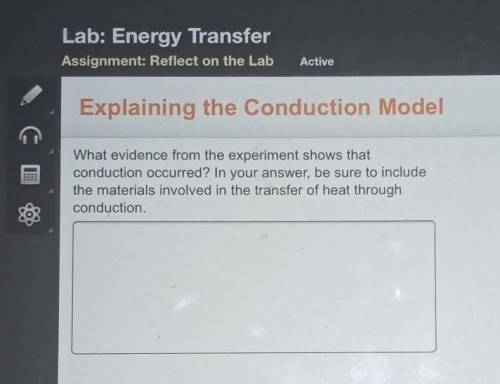
Physics, 29.12.2020 21:00 hhhhhh8897
What evidence from the experiment shows that conduction occured? In your answer, be sure to include the materials involved in the transfer of heat through conduction.


Answers: 1
Another question on Physics

Physics, 21.06.2019 15:20
Two large, flat, horizontally oriented plates are parallel to each other, a distance d apart. half way betwween the two plates the electric field has magnitude e. if the separation of the plates is reduced to d/2 what is the magnitude of the electric field half way between the plates?
Answers: 2

Physics, 21.06.2019 19:30
Density of salty water as compared to the density of pure water is(a) is less(b) is always equal(c) is always more(d) may be less or more
Answers: 1

Physics, 21.06.2019 23:30
Classify the following soils according to the uscs classification system. provide appropriate uscs designations. a) this sample of well-graded gravel with sand was obtained from a large earthen dam in vancouver, canada. the sample has 73% fine to coarse sub-angular gravel, 25% fine to coarse sub-angular sand and 2% fines. the maximum size of the particles is 75 mm. the coefficient of curvature is 2.7, while the uniformity coefficient is 12.4. b) this dark brown and wet soil with a “strong organic odor” has 100% passing the no. 200 sieve. the liquid limit of the material is 32% when not dried and is 21% when oven-dried. the plastic index is 21% when not dried. c) this sand has 61% predominantly fine sand, 23% silty fines, and 16% fine sub-rounded gravel size. the maximum size is 20 mm. the liquid limit is 33% and the plastic limit is 27%. d) this soil has 74% fine to coarse sub-angular reddish sand and 26% organic and silty dark brown fines. the liquid limit is 37% when not dried and is 26% when oven dried. the plastic index is 6% when not dried.
Answers: 1

Physics, 22.06.2019 01:30
For problems 1-3, consider a simple dc brush motor with a permanent magnet stator. with an an consider a simple dc brush motor with a permanent magnet ae supply voltage of 100 v, the no-load speed of the motor is 1000 rpm. this motor can provide a torque of 1.9 n-m at 800 rpm drawing a current of 2 a current are both zero at no load.) 1. with an armature supply voltage of 100 v, the motor is operated at 900 rpm. what is the motor torque? what is the mechanical power delivered by the motor? what is the current draw? what is the electrical power input? what is the energy efficiency of the motor? with an armature supply voltage of 100 v, the motor is operated at 1100 rpm (where it acts as a generator). what torque input is required? what mechanical power is required what current is generated? what is the electrical power generated? what is the energy efficiency of the motor acting as a generator? 2. with an armature supply voltage raised to 120 v, the motor is operated at 1000 rpm. what is the no-load speed? what is the motor torque? what is the mechanical power delivered by the motor? what is the current draw? what is the electrical power input what is the energy efficiency of the motor? 3.
Answers: 3
You know the right answer?
What evidence from the experiment shows that conduction occured? In your answer, be sure to include...
Questions

Mathematics, 24.03.2020 18:23




Mathematics, 24.03.2020 18:24



Business, 24.03.2020 18:24


English, 24.03.2020 18:24

Mathematics, 24.03.2020 18:24

Computers and Technology, 24.03.2020 18:24





Biology, 24.03.2020 18:25

Mathematics, 24.03.2020 18:25




